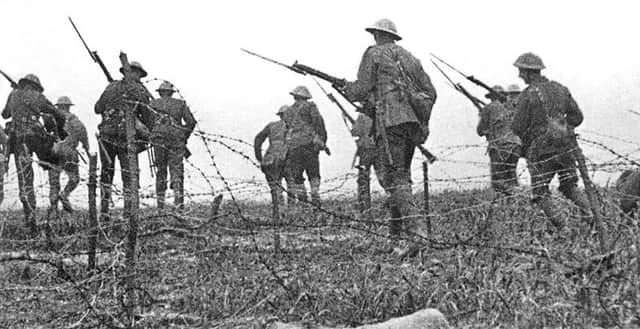Preparing for offensive


“Charles was born in 1887, in Jarrow,” explains Dororthy.
“His father, George Watson Howey, who had been born in 1859, was working there as a grinder. He and his wife Alice, also born in 1859, (nee Hood, the daughter of a Morpeth farmer with 218 acres), had married in 1883, and in 1891, the family were living at 61 McIntyre Street, Jarrow.
“By 1901 they had moved to 115 Robinson Street in South Shields, where dad George was employed as a bricklayer.”
Advertisement
Hide AdAdvertisement
Hide AdThe family consisted of Charles, who at that time was an apprentice moulder, his brother George William, born in 1888, his sisters Beatrice (1892) and Charlotte (1898) and little brother Ralph Milburn Howey (named after his mother’s uncle, a butcher in Hexham) who was born in 1899.
“In 1911, the Howey family moved once more, this time to 11 Isabella Street.
“Dad George was a stoneman in the coal mine and son Charles a sinker in the mine, the other son George was a coal hewer.
“Sadly, Charles’ service record no longer exists, many of them were destroyed by the Luftwaffe in the Second World War.
Advertisement
Hide AdAdvertisement
Hide Ad“Presumably he enlisted in the Tyneside Scottish early in May 1915, which would have found him in Alnwick camp, then in June, in Ripon for training.
“In August they were sent to Salisbury Plain for final training and firing practice. Then on January 3, 1916, they were told to get ready for embarkation to France.”
By January 15, the regiment was stationed at La Crosse, east of St Omer, and would soon see action.
“On June 6, they were involved in the defence of Becourtwood HQ, St Becourt Chateau, and nine days later marched to Albert, near La Boisselle, then on to Bresleand, the Usna Tara Line, where they occupied the forward trenches, in readiness for the forthcoming attack.”
Advertisement
Hide AdAdvertisement
Hide AdDorothy goes on to explain that the Germans had already set up trenches in this area, so were well dug in – and they had the best defensive positions.
Their trenches were connected by underground passages, with dugouts strong enough to withstand the heaviest bombardments.
The machine gunners had their guns on pulleys to be able to bring them into action quickly.
“La Boisselle was flanked by two valleys on either side, the one on the south was called Sausage, and the northern valley predictably called Mash.
Advertisement
Hide AdAdvertisement
Hide Ad“The British line, known as the Glory Hole, was 50 yards from that of the Germans. Any attack, either towards the elevated village, or via the long unprotected valleys were both deadly, if not suicidal.
“The plan selected was to attack up the valleys.”
Dorothy says the day the battle of the Somme really began was June 24, 1916 (a dull day with low cloud and heavy rain), when preparation for the forthcoming assault got under way.
“The essential cutting of barbed wire began – an obstacle which is understandably deadly for infantry during an assault.
“June 25 dawned much brighter and warmer, and the wire cutting continued. At night, the infantry sent out raiding parties to judge the enemy situation at La Boisselle, where the Tyneside Scottish were to eventually attack, and it was found strongly held by an alert, pugnacious enemy.”
Advertisement
Hide AdAdvertisement
Hide AdThe following day was again wet, but with some sunny intervals.
“Smoke and gas were used, and the artillery bombarded the enemy while the wire cutting continued.
“During the next two days, there was thick mist and heavy rain, so that conditions in the trenches must have been grim.
“The last of their gas supplies were released on the enemy and bombing continued. Unfortunately, despite these measures, raiding parties found the Germans in greater numbers and more alert to attack.”
Advertisement
Hide AdAdvertisement
Hide AdThe weather brightened on June 29 and 30, but the outlook was far from bright – “worryingly, 171 enemy batteries were spotted in action, firing machine guns and artillery barrages on No Man’s Land.
“On June 30, although it was only hours before the main assault of the Battle of the Somme began, infantry again went out on patrol.
“They all reported that the German frontline was now strongly held, which was not reassuring.
“Much of the shelling had been useless, as the artillery were firing faulty shells which did not explode. It has been alleged that between 20-30% of shells fired failed to detonate due to faulty fuses or being incorrectly armed. To this day many are still being discovered on Western Front battlefields.”
Tomorrow, Dorothy continues her account, describing the official start of the Battle of the Somme – and the terrible events and casualties that followed.